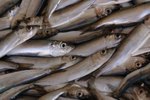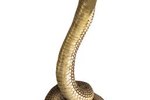A fierce carnivore, the shrew is found worldwide, with more than 250 known species. Often mistaken for a mouse, a shrew has a pointed snout and tiny eyes and ears, features that distinguish it from the shorter snout, large eyes and visible ears of the common mouse. The tiny shrew is the gardener's friend, eating up to three times its body weight daily in insects and various other bugs.
Insects and Insect Larvae
A large part of the shrews' diet includes insects and insect larvae. Bees, beetles, butterflies, crickets, grasshoppers, moths, wasps, and their larvae, including caterpillars, are among the insects hunted by shrews. Some species, such as the southern short-tailed shrew (Blarina carolinensis), also eat ants.
Slugs and Snails
The slow-moving snails and slugs that infest gardens and moist woodlands are easy prey for the ravenous shrew. In the coastal regions of the Pacific Northwest, snails and slugs are the primary prey of the Pacific shrew (Sorex pacificus). They are also eaten in lesser amounts by the vagrant shrew (S. vagrans), marsh shrew (S. bendirii) and other shrew species in the area.
Earthworms
Depending on the species, shrews may be active during the day or at night. By using the tunnels burrowed by moles and voles, and hunting during foggy and wet weather, a shrew can add a significant number of earthworms to its diet. Although tiny, shrews such as the masked shrew (Sorex cinereus) readily attack night crawlers, despite the worm's size.
Spiders, Millipedes and Centipedes
Shrews also hunt and eat arthropods such as spiders, millipedes and centipedes. By rooting through the dead leaves and twigs littering the forest floor and burrowing under logs, or by using their sharp senses of hearing and smell, shrews can locate and attack wandering spiders or other arthropods in their dark, moist hiding places. The pygmy shrew (Sorex hoyi), weighing less than a penny and known as the smallest mammal in the world, eats mostly arthropods.
Other
In addition to eating a variety of bugs, shrews eat bird eggs, mice, snakes and other shrews. They are aggressive little carnivores, feeding mostly on insects and other creatures, although a few shrew species also eat seeds and roots when their preferred foods aren't available. A few shrews, such as the Eurasian water shrew (Neomys fodiens), northern short-tailed shrew (Blarina brevicauda) and southern short-tailed shrew have poisonous saliva, which enables them to attack and kill large insects, snakes and small mammals.
References
- Utah State University Department of Fisheries and Wildlife: Shrews
- Professional Pest Control Products: Southern Short-Tailed Shrew
- Oregon State University, HJ Andrews Experimental Forest: Food Habits of Five Western Oregon Shrews
- Montana Outdoors: Terror on Tiny Feet
- U.S. Forest Service: Pygmy Shrew (Sorex hoyi): A Technical Conservation Assessment
- Smithsonian National Museum of Natural History: Blarina Brevicauda - Northern Short-Tailed Shrew
- Animal Diversity Web: Neomys Fodiens - Eurasian Water Shrew
Resources
Writer Bio
With degrees in fine and commercial art and Spanish, Ruth de Jauregui is an old-school graphic artist, book designer and published author. De Jauregui authored 50 Fabulous Tomatoes for Your Garden, available as an ebook. She enthusiastically pursues creative and community interests, including gardening, home improvement and social issues.




